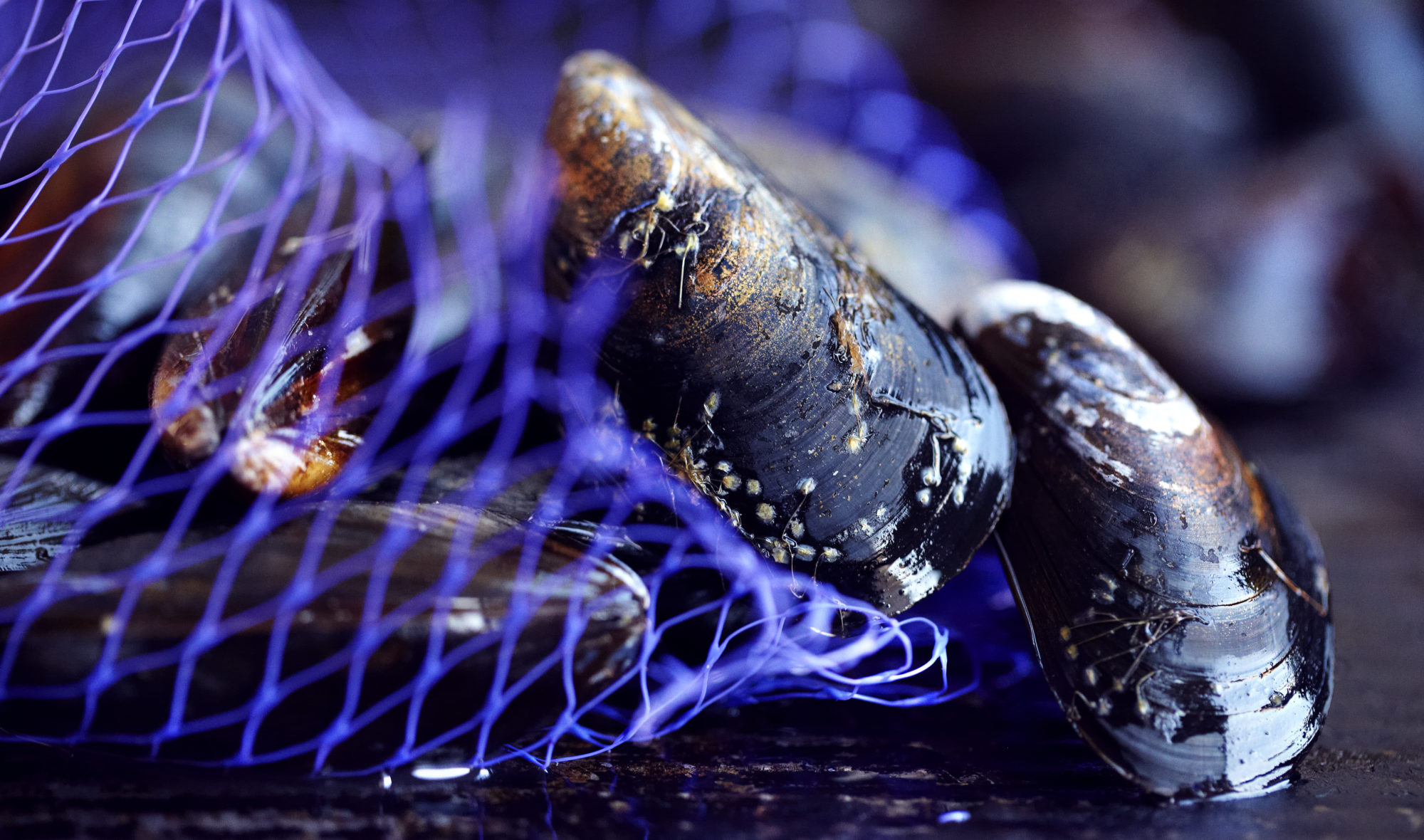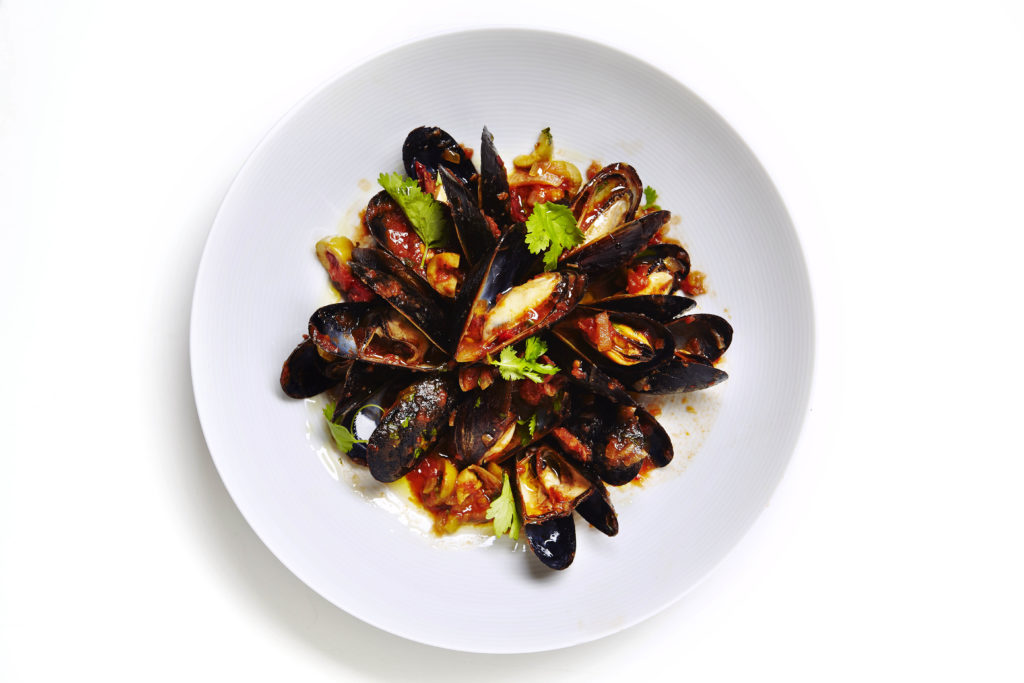Mussels


The marine mussel, and in particular, the common “blue” mussel, is a mollusk that lives in saltwater and may be harvested for food. Both cultivated and wild varieties exist. Mussels are a nutritious seafood offering a variety of vitamins and minerals. Prepare mussels quickly and easily by steaming them in a liquid of your choice.
The term “mussel” refers to a number of different types of mollusks. This encyclopedia entry focuses on edible marine mussels, and in particular, the common “blue” mussel.
Marine mussels are a type of bivalve mollusk that live in saltwater. Under the water, they use threads to attach themselves to underwater structures such as rocks. Inside their pearly-black shell is an edible “meat” — yellow or orange gills that can be eaten once cooked.
The blue mussel is the type most commonly harvested for food. They can be cultivated or caught wild. In the US, mussels are cultivated in Washington state and New England, though they are also imported from other countries including Canada and New Zealand.
Mussels are enjoyed in many European cuisines including French, Spanish, Portuguese, Dutch, Belgian, and Italian.
Mussels have a thin, shiny blue-black external shell that is narrow and somewhat pointed. The shell is composed of two hinged halves or “valves”.
Mussel meat, inside the shell, varies in color from yellow to a deep orange. It is a small nugget of meat resembling gills.
Three ounces of steamed mussels contains 146 calories, 20.2g of protein, 3.8g of fat, and 6.3g of carbohydrates.
Mussels contain many vitamins and minerals: they are a very good source of vitamin B12, iron, manganese, and selenium. They’re also good source of vitamin C, thiamine, riboflavin, phosphorus, and zinc.
Of note, mussels are considered high in cholesterol.
Freshness is imperative when choosing mussels. (Mussels that are past their freshness can cause extreme digestive distress.) They are usually sold in mesh bags or loose in the seafood counter. Regardless, they should be kept very cold.
Buy mussels from a trusted fishmonger or reliable supermarket and check the expiry date (this should be on the tag of the mesh bag).
Before buying, smell the mussels: they should smell fresh and salty like the ocean. Do not buy mussels that smell funky or “off”.
Keep in mind that each mussel contains a small morsel of meat. About 1 pound of mussels per person is usually suitable.
As an alternative to fresh mussels, you can sometimes find frozen mussels, or pre-prepared mussel meat. However as a general rule of thumb, fresh, living mussels are best.
Purchase mussels close to the day you plan to eat them.
If you’re not ready to eat them right away, they can be kept in the fridge for a couple of days. Never store live mussels in a sealed container or in water. Instead, put the mussels in a bowl or tray and cover them with a damp paper or kitchen towel. Put them at the far back of your refrigerator. Drain off any liquid occasionally as it appears in the bowl. They can usually stay fresh for 2-3 days.
If you have leftover cooked mussels, remove the meat from the shell and store it in a sealed container for 1-2 days.
To cook the mussels you will first need to rinse them in very cold water and remove the beards — the black stringy bits that still hang on the mussel. (In some cases, this will already have been done for you.) Removing these stringy bits is called “debearding”. To debeard mussels, simply pull off the stringy bits with your fingers.
As you are cleaning the mussels, any open shells should snap firmly shut. If they stay open, give them a gentle tap — and if they still don’t close, discard them.
Once cleaned, preparing mussels is pretty simple and quick.
Steaming mussels is a classic — not to mention tasty, nutritious, and easy — way to cook mussels. All you need is a large pot. As an optional first step, saute any aromatics such as garlic, onions and herbs in your pot. Then pour liquid — water, wine, beer, or broth — into the pot and turn on high. (About 1.5 cups of liquid to 4 pounds of mussels.)
Add the mussels to the liquid, cover, and cook. When steam starts to emerge from the pot, open the lid and check to see if the mussels are opened. (This takes about 5-6 minutes for 4 pounds of mussels.)
When the mussels are opened, they are ready to eat. Pour the contents of the pot — broth and all! — into a bowl. You now have a tasty, savory broth to enjoy with the mussels. Serve with crusty bread to soak up the broth.
You can use a regular fork or seafood fork to pull the meat out of the mussels. (Though some people prefer to slurp the mussel meat directly out of the shell!) When eating, discard any mussels that have not opened.
The basic steamed mussels recipe can be embellished upon in many ways. Try enhancing your mussel broth with cream, tomatoes, curry, or fragrant herbs. Mussels can also be included in fish stews, chowders, and seafood boils. Or try roasting or baking mussels.

This dish is sure to impress! Please your taste buds and "wow" your friends with these delicious mussels. This recipe makes for a great side dish or appetizer.
Prep Time: 15 minutes Cook Time: 20 minutes Yield: 4 servings
With a brush or kitchen cloth, scrub the mussels clean and remove any “beards” that loom around the shell. Put into the fridge until ready to use.
Heat a large pot on medium heat. Once hot, add olive oil. Add the onions, chorizo, chile flakes, and anchovies. Sauté for one minute. Add the smoked paprika and sauté for another 30 seconds. Add tomatoes, Worcestershire sauce, and vinegar. Mix together. Bring to a boil, then immediately simmer on lower heat. Once the heat has been lowered, add the olives and garlic. Cook the sauce for about 15 minutes.
Add the mussels to the pot, mixing around to even everything out. Put the lid on, turn the heat up to medium and cook until the mussels have opened up (about 5 minutes). Add the chopped cilantro and mix everything in the pot.
Discard any closed mussels – these are dead and can cause illness if you try to pry open and eat them.
In a bowl serve the mussels with some of the sauce, and top each bowl with some cilantro leaves and some extra virgin olive oil if desired.
Precision Nutrition’s Encyclopedia of Food expands every single month as we highlight new foods and showcase beautiful food photography. If you’d like to stay up to date, simply click this link. From there, we’ll send you a FREE copy of our recipe book. We’ll also let you know when new and delicious foods are added to the site.
The marine mussel, and in particular, the common “blue” mussel, is a mollusk that lives in saltwater and may be harvested for food. Both cultivated and wild varieties exist. Mussels are a nutritious seafood offering a variety of vitamins and minerals. Prepare mussels quickly and easily by steaming them in a liquid of your choice.